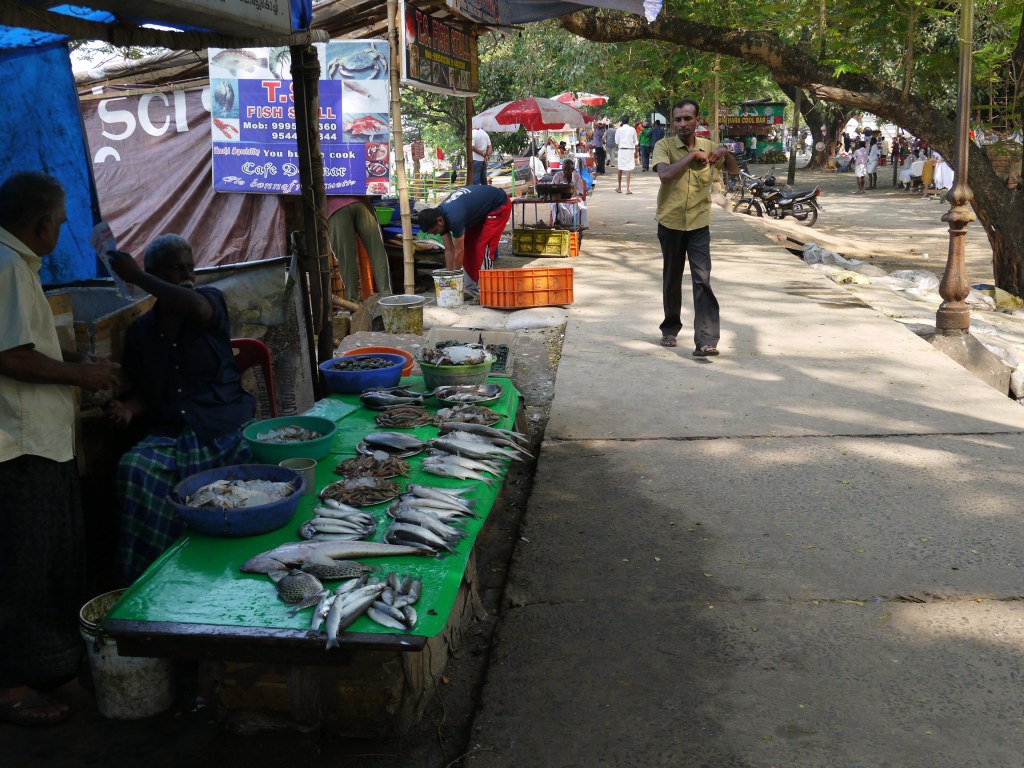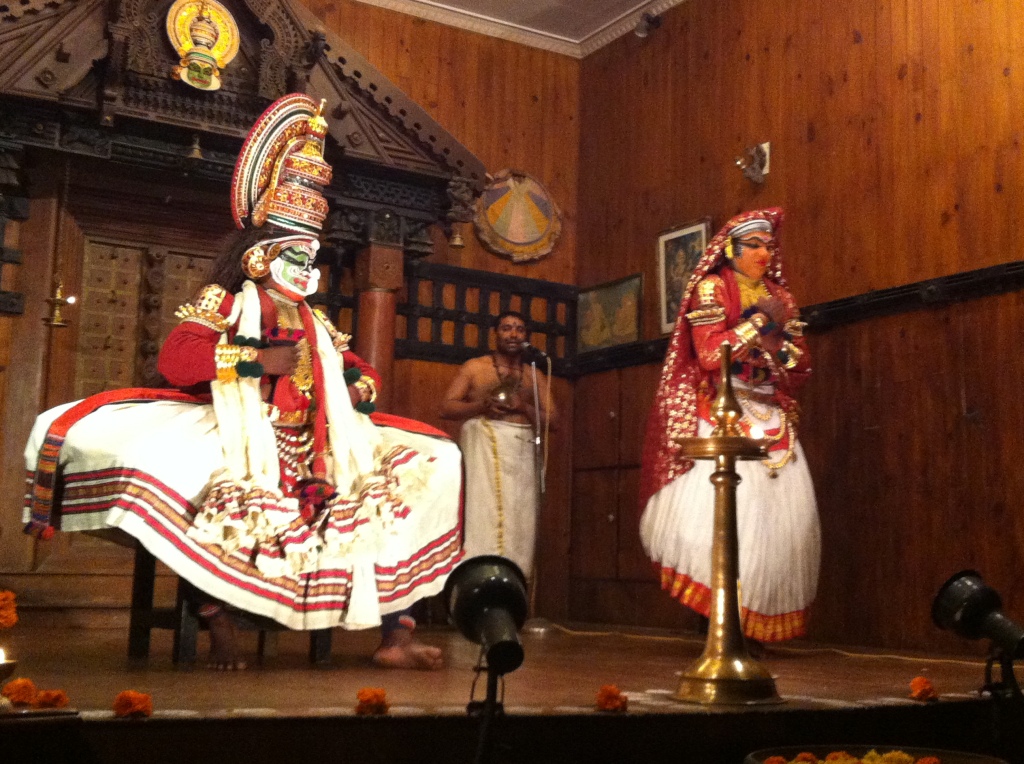Kerala is the one state in India that I’ve wanted to visit since my year in Japan; photos of serene backwaters summoning me. I even bought a guide book for South India, hoping to visit. Nearly 13 years later I made it to Fort Cochin (Kochi), one of the tourist destinations on the tropical southwest coast. This was not the India I had become acquainted with. It lacked crazy traffic, blaring horns and trash piles along the roadside. The seafood is fresh and curries are made with coconut. It reminded me more of Thailand than India, and at times I even mistakenly converted prices from Thai baht instead of rupees.
Fort Cochin was colonized by the Portuguese and then the Dutch before the British took over, and those influences can be seen throughout the city in both the architecture and the food. The Santa Cruz Basilica is one of the most beautiful buildings in the city, originally built by the Portuguese in the early 16th century and rebuilt many years later. Many guesthouses in town are beautiful colonial buildings, referred to as “Heritage Homestays”.
This small fishing village is very walkable, with most sites within less than a mile from the center. The narrow, shaded streets wind through the town and along the beach where the famous Chinese fishing nets can be seen. These huge nets are completely man powered, and Kerala is the only place outside of China where they’re used. The structure is bamboo and uses a lever system with ropes and rocks to raise and lower the nets. To go down, the ropes are released and a fisherman walks the length of a bamboo pole over the water, his weight pushing the net under. After several minutes, the ropes are pulled and the catch is taken from the net. The fresh seafood is sold at stalls just steps away, and if you’re hungry, you can take your purchase to any of the “cook and eat” stalls where they’ll serve it up hot on a plate.
I ended up staying in Fort Cochin for two weeks instead of one since I had to cut my week in Bangkok due to the protests. While there isn’t much to do for two weeks, it was a nice place to relax, virtually catch up with friends and recoup some of the money I spent changing my travel plans. My guesthouse was simple, but sufficient, and at $13/night it was a good place to plant myself. Most days were spent walking around the town, plopping myself in a wifi-enabled café for a few hours and eating. I managed to run into the same New Zealand couple three times during my last few days.
On the cultural end, I did see a traditional Kathakali dance show, known for its extravagant make-up and costumes. It was a little long, but cool to see.
Mid-trip I met an Argentinian woman who was staying at the same guesthouse and had checked out hoping to catch a train to Mysore. Turned out she wasn’t able to do what she planned (shocker), so she stayed two more days and shared my room. It was nice to have the company. Valeria is in her early 30s and left Argentina for the first time two years ago to visit Peru and Bolivia with her sister. Now she was traveling to India by herself for a month. I was very impressed that her first solo journey, without much prior international experience, was to India. The south is definitely a bit easier than the north, but it’s still an intimidating country and logistics can be, um, shall we say, CHALLENGING. We hit up the Dutch Palace and ventured via ferry, bus and autorickshaw to Cherai beach. We were both quite impressed we were able to make it to the beach and back without getting completely lost. Because Indians are so conservative, they go in the water with their clothes on, or don’t go in at all. The landscape is much different from anything I’d seen before, and I loved watching colorful saris glide across the sand. Beautiful juxtaposition.
As for my non-touristy experience, I ended up visiting the home of my guesthouse owner’s niece, who was hanging out in the common area one afternoon. She’s nine years old and speaks five languages, naturally. Rosetta Stone, I may be knocking soon. Her home was in the Muslim area of town and, as with most Indians, the hospitality was overflowing. Her mom was all smiles and brought me tea with a traditional masala dosa, which I ate alone as she only made it for me! Then a cousin came over to adorn my hand and arm with mehendi, a temporary henna tattoo often worn for weddings and special occasions. It was a lovely afternoon and a nice break from the tourists along the beach, of which there are many in Fort Cochin.
Earlier during my two-week stay I headed to Alleppey for a few days to see the backwaters. Alleppey is the most common jumping off point for houseboats (or boat houses, as they are sometimes called) and canoe rides through the canals. While only about 90 minutes away by car, I stayed two nights, and I think I’m the only one who did. I stayed at two different guesthouses and at both of them I was the only one there! Perhaps most people only do day-trips or spend the night on a houseboat, but it was very odd. The first place had a Stephen King-like vibe so I moved to the Palm Grove Lake Resort, partly because they also had an arrangement with a canoe guide who docked his boat at the guesthouse. I figured if I was going to move, I should at least make it convenient for the five-hour backwater tour I booked. At first I was concerned that I booked too long of a ride as we were going really slowly, but by hour four I didn’t want it to end. We passed large exhaust-spewing vessels on the bigger waterways, but the small canals were remarkably peaceful. Houses lined the water and locals could be seen walking, fishing and washing clothes. Aside from birds, the only other sound was the paddle moving slowly through the water. Swoosh, trickle, swoosh, trickle, swoosh, trickle. Why don’t they make white noise CDs with that sound instead of waterfalls and ocean waves? I almost fell asleep twice, but I didn’t want to wake up and have the trip be over so I didn’t allow myself to drift off. Lush trees shaded the canals with streams of sunlight pushing their way through, shimmering on the water. This is what I came here for, and it was worth the wait. Towards the end of the ride I wished I’d booked it for eight hours instead of five, but I suppose all good things must come to a close. Kerala, you were the exclamation point at the end of India.

















Pingback: Rosario- Argentina’s City on the River | Plans Subject to Change
You really know how to describe Kerala!!!
I believe that you exaggerated respect of myself, but even this way I feel very proud of me! jajjaja. Thank you for sharing your time with me!!! It was funny and I felt really comfortable with you… You are a very sensitive and kind person…
I wait anxious for your posts from Argentina, where we wait for you when you want… 😉 I will be traveling with your posts… =D
P. S.: Good photographs!!!
I forwarded your blog to Marlena, turns out she has friends visiting Mysore . . I understand that that’s North of you. .
Hi Nancy! Yes, Mysore is just north of where I was. I would definitely recommend Fort Cochin and Alleppey if they’re headed south.
Oh Shelley…….I so enjoy reading about your travels. You are an amazing women. Your pictures are just gorgeous !
Thanks, Linda! The scenery made it hard to take a bad shot.
Beautiful photos! What’s the next stop?
Thanks, Vicki! I’m in Cambodia now, but my next post will be on Myanmar. I’ve got to catch up!
Pingback: Kochi (Cochin), Kerela, Indian known and marketed as “Gods Own Country” « Discover the Orient